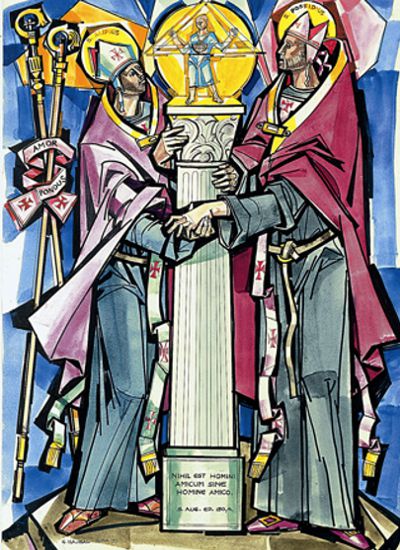
Saint Alypius - 16th May
Our celebration today honors the memory of two saints who were intimate friends of Saint Augustine and members of his religious community. Like him they were also called to ministry as bishops in North Africa and served the Church well especially in helping to reveal the fallacies of unorthodox teachings at the time. Their love for religious life according to the inspiration of Augustine helped to spread its influence in North Africa.
Alypius was born in the middle of the fourth century in Tagaste, Africa, to parents who were influential citizens of that city. He studied law in Rome, but first met Augustine while at school in Carthage. Augustine praised Alypius, whom he called "the brother of my heart", for his honesty, sincerity and sense of justice. Like Augustine, Alypius was at one time a Manichean. The two friends were both converted to the Catholic faith and were baptized together by Saint Ambrose in 387. Alypius was a member of Augustine's first monastery in Tagaste. When Augustine was ordained a priest in Hippo, and founded a community in that city, Alypius joined him there, and was subsequently ordained bishop of Tagaste around 384. He once traveled to the East, where he met the great biblical scholar Saint Jerome. He took part in the African Councils of the Church during his time as bishop, and was chosen along with Possidius and Augustine to represent the Catholic bishops at the famous meeting with the Donatists in Carthage in 411. He took part in the Council of Milevi (Numidia) in 416 and composed a written report on this Council for Pope Innocent. Alypius travelled to Italy several times as part of his opposition to the Pelagian heresy. He carried Augustine's writings with him in order to present them to Pope Boniface. It is believed that he was present at the death of Augustine in 430. Alypius died shortly thereafter, probably later in the same year.
The Order has celebrated the feasts of Alypius and Possidius since 1671. Clement X confirmed devotion to them on August 19, 1672. The memory of these two saints is closely tied, both as monks and bishops, to that of Saint Augustine. They are, in fact, the two greatest representatives of his monastic legacy. However, it is not for this reason alone that history remembers them. They were dedicated Christians, religious and shepherds of the Church in their own right.

